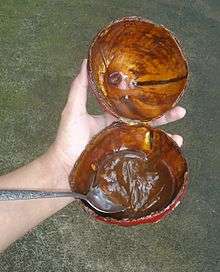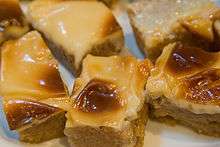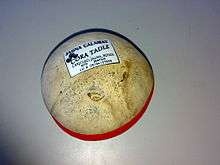Kalamay
|
Kalamay from Bohol packaged inside empty coconut shells. | |
| Alternative names | Calamay |
|---|---|
| Course | Dessert |
| Place of origin | Philippines |
| Region or state | Visayas, Southern Luzon |
| Serving temperature | Hot, room temperature, cold |
| Main ingredients | Coconut milk, glutinous rice, brown sugar |
|
| |

Kalamay (also spelled Calamay), which means "sugar", is a sticky sweet delicacy that is popular in many regions of the Philippines. It is made of coconut milk, brown sugar, and ground glutinous rice. They can also be flavored with margarine, peanut butter, or vanilla. Kalamay can be eaten alone but is usually used as a sweetener for a number of Filipino desserts and beverages.[1] It is similar to the Chinese Nian gao (also known as tikoy in the Philippines) but is sweeter and more viscous. A cousin of kalamay is dodol, found in Indonesia, Malaysia, Brunei, Singapore and in some parts of the Philippines.
Preparation
Kalamay is made by extracting coconut milk from grated coconuts twice. Glutinous rice is added to the first batch of coconut milk and the mixture is ground into a paste. Brown sugar is added to the second batch of coconut milk and boiled for several hours to make latík. The mixture of ground glutinous rice and coconut milk is then poured into the latík and stirred until the consistency becomes very thick. It can be served hot or at room temperature especially when eaten with other dishes. Viscous Kalamay are often served cooled to make it less runny and easier to eat.
Consumption
Kalamay is a popular pasalubong (the Filipino tradition of a homecoming gift). They are often eaten alone, directly from the packaging.[2] Kalamay is also used in a variety of traditional Filipino dishes as a sweetener.[1] This includes Suman and Bukayo. It can be added to beverages as well, like coffee, milk, or hot chocolate.
Biko and Sinukmani are similar dishes which use whole glutinous rice grains. The preparation is the same except that the glutinous rice is cooked whole and not ground into a paste. It is smothered with latík as well. In some regions (particularly in the Northern Philippines), this dish is referred to as "Kalamay", while the viscous kind is differentiated as Kalamay-hati.
Latík can also be used with other desserts, particularly with dishes made from cassava (it is then referred to as 'cassava kalamay').


Types of Kalamay
There are many variations and types of kalamay. Kalamay can be divided roughly into two types: the syrupy kind used in conjunction with other dishes, and the gummy chewy kind which is more expensive and usually eaten on its own.[2]
Varieties include the following:
- Bohol Kalamay - Kalamay from the island of Bohol can vary from extremely sweet to mildly sweet. It is distinctive for being sold inside halved smooth coconut shells (the mesocarp of coconuts, locally known as bagol or paya). These containers are then sealed shut with a characteristic red crepe paper (papel de japon).[2] This type of packaging is known as Kalamay-hati (literally 'Half Kalamay').[3]
- Baguio Kalamay - a type of Kalamay from Baguio City, Philippines. It is also known as Sundot Kulangot (literally 'Picked Booger') because of its consistency. It is sweetened with molasses which adds to its color. It is uniquely packed into halved pitogo (Sago Palm of the genus Cycas) shells and sealed with red crepe paper in a similar manner to the Bohol Kalamay. It is the smallest known traditional packaging of Kalamay. They are sold in bundles, several of these kalamay balls are nestled inside split bamboo and tied with a string.[3]
- Iloilo Kalamay - Kalamay from the province of Iloilo and the island of Negros. It is thicker in consistency than other types of Kalamay. The city of San Enrique celebrates a Kalamay festival.[4]
- Candon Kalamay - Kalamay from Candon City, Ilocos Sur.[3] It is sold wrapped in banana leaves or in coconut shells, though modern packaging uses polystyrene containers wrapped in cellophane. Candon City also celebrates a Kalamay Festival.
- Nilubyan or Iniruban- a kind of Kalamay made from pounded green rice. It originates from Camiling, Tarlac in the Northern Philippines.[3]
- Mindoro Kalamay - a version of Kalamay from the island of Mindoro. It usually contains grated coconut and is flavored with peanut butter or vanilla.[3]
- Indang Kalamay - Calamay Buna is a sweet delicacy of sticky rice, brown sugar and coconut milk that is well known in Indang Cavite. This variety of calamay from Indang is made from glutinous powderized rice called malagkit mixed with coconut milk and panutsa.[5]
Origin
Kalamay, in many Visayan languages (particularly Hiligaynon), is synonymous with 'Sugar'.[6] Its production has been known since the Spanish colonization of the Philippines. In the Waray language, kalamay refers to a hardened cake of molasses used as sweeteners for many cooked desserts.
See also
References
- 1 2 Vicente Labro (2006-11-18). "'Kalamay'-making survives high-tech sugar mills". newsinfo.inquirer.net. Retrieved January 7, 2011.
- 1 2 3 "Calamay from Bohol". marketmanila.com. 22 June 2010. Retrieved January 7, 2011.
- 1 2 3 4 5 Edgie B. Polistico (December 18, 2010). "Pinoy Food and Cooking Dictionary - C". EDGIE POLISTICO’S encyclopedic PINOY dictionary. philfoodcooking.blogspot.com. Retrieved January 7, 2011.
- ↑ "Municipality of San Enrique and the Kalamay Festival". iloilohangout.tigaswebs.com. 2008. Retrieved January 7, 2011.
- ↑ "Calamay Buna, a Sweet Delicacy from Indang, Cavite". wowcavite.com. 2011. Retrieved March 31, 2015.
- ↑ Jenny B. Orillos (June 21, 2010). "Sweet and Sticky Pinoy Treats: Our Top 10 Kakanin". spot.ph. Retrieved January 7, 2011.
External links
![]() Media related to Kalamay at Wikimedia Commons
Media related to Kalamay at Wikimedia Commons
